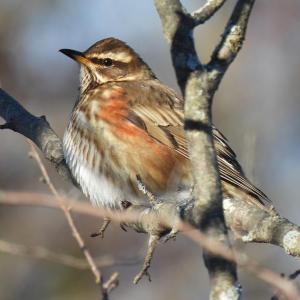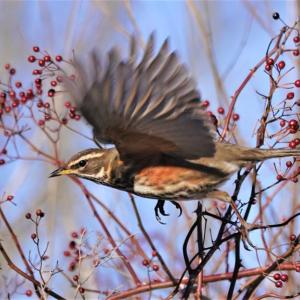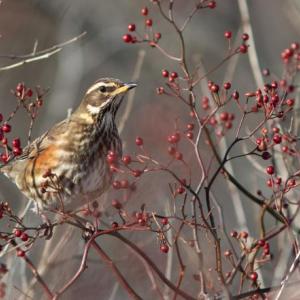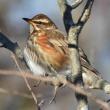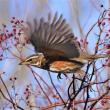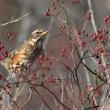A Redwing Unlike Any You’ve Seen Before
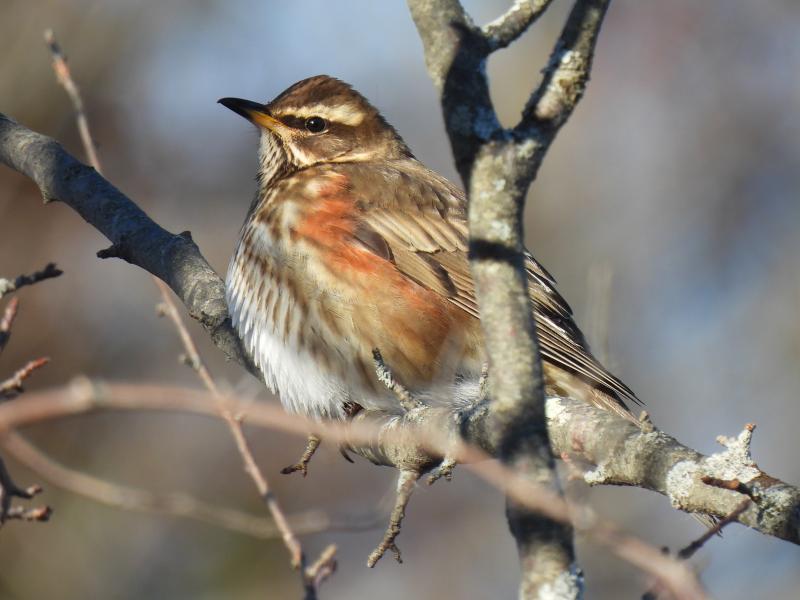 This redwing, a Eurasian thrush, was found in Portland this past week, the second record for the species in Maine. Matthew Gilbert photo
This redwing, a Eurasian thrush, was found in Portland this past week, the second record for the species in Maine. Matthew Gilbert photo
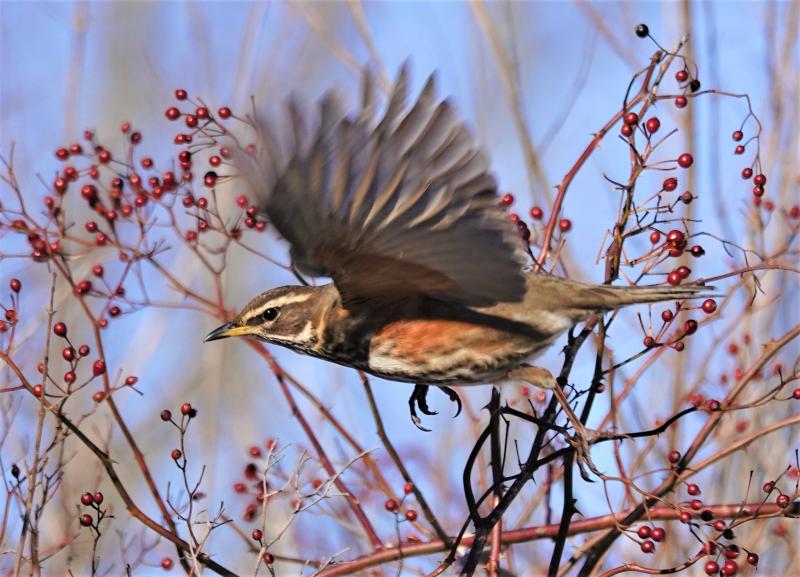 The reddish underwings, for which this bird is named, are evident in this photo, taken at Capisic Park in Portland. Marie Jordan photo
The reddish underwings, for which this bird is named, are evident in this photo, taken at Capisic Park in Portland. Marie Jordan photo
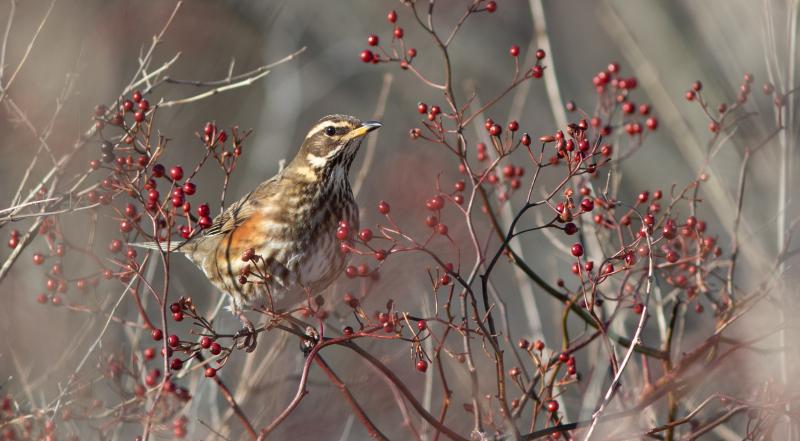 Like its cousins, the American robins, the redwing eats natural fruits and berries in winter, as this celebrity visitor was doing at a park in Portland while many socially distanced birders looked on. Doug Hitchcox photo
Like its cousins, the American robins, the redwing eats natural fruits and berries in winter, as this celebrity visitor was doing at a park in Portland while many socially distanced birders looked on. Doug Hitchcox photo
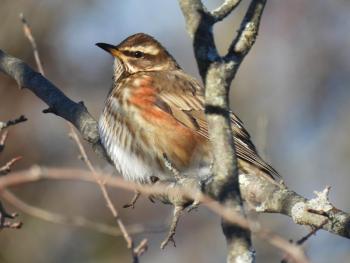 This redwing, a Eurasian thrush, was found in Portland this past week, the second record for the species in Maine. Matthew Gilbert photo
This redwing, a Eurasian thrush, was found in Portland this past week, the second record for the species in Maine. Matthew Gilbert photo
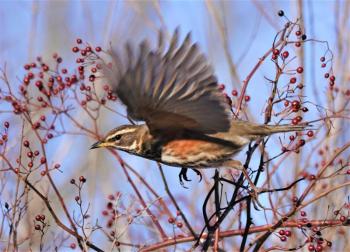 The reddish underwings, for which this bird is named, are evident in this photo, taken at Capisic Park in Portland. Marie Jordan photo
The reddish underwings, for which this bird is named, are evident in this photo, taken at Capisic Park in Portland. Marie Jordan photo
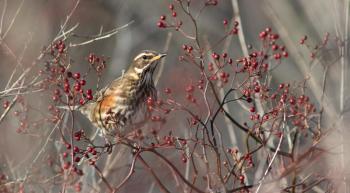 Like its cousins, the American robins, the redwing eats natural fruits and berries in winter, as this celebrity visitor was doing at a park in Portland while many socially distanced birders looked on. Doug Hitchcox photo
Like its cousins, the American robins, the redwing eats natural fruits and berries in winter, as this celebrity visitor was doing at a park in Portland while many socially distanced birders looked on. Doug Hitchcox photo
Most people in Maine eagerly look forward to the return of the bird species that is commonly referred to as the “redwing.” That’s the slightly-smaller-than-a-robin sized blackbird with the bright red shoulder patches that nests in wetlands throughout the state. They migrate south in winter (most of them to, at least) and return in the late winter and early spring. Technically, that species is really the red-winged blackbird, but many people just call it the “redwing” for short.
So you’d be excused for not getting initially excited if you heard through the grapevine that a redwing had been found in the state this past week.
That is, unless you also knew that the bird officially named the redwing (notice we did not put quotation marks around the name this time) was a Eurasian species that had never been found in Maine until this year.
This redwing (scientific name Turdus iliaca, just to be clear) is a species that breeds in Iceland, Scandinavia, and Russia, with apparently increasing numbers in southern Greenland. Redwings move south to winter in central and southern Europe as well as northern Africa and the Middle East. A few may stay in Iceland during the winter as well.
Maine’s first redwing was found a few weeks ago in Steuben, but the bird disappeared soon after and was never seen again. Amazingly, a second redwing was found at Capisic Park in Portland just last week. We made a family trip down over the weekend, bringing our son and his girlfriend, who both saw the bird before we did. When we arrived up the path, the bird had disappeared into the dense shrubbery. We had to stand in the bitter cold with other birders (all masked and socially distanced!) for a bit longer until the thrush popped up and delighted us with wonderful views as it fed on berries in a brushy tangle.
Unlike the red-winged blackbird, the redwing is a thrush that, in shape, size, and behavior, is remarkably similar to our own American robin. In fact, the Capisic Park redwing, like many of the individuals that have been found in North America, was hanging out with a flock of American robins. In contrast to the American robin, the redwing has a brown streaked breast rather than a solid orangey breast, and it has a white eyeline rather than the solid dark head and white semicircles around the eye that our American robin has. The redwing has small patches of reddish orange on the sides of the breast that extend under the wing into the bird equivalent of the human “armpit” and under the wing. When the bird flies, a flash of this reddish-orange is visible each time it opens its wings. Hence the origin of its name—redwing.
The range of this Eurasian bird is quite similar to another bird that excited the birding community here in Maine a few years ago, the fieldfare, which we wrote about in this column.
Both the fieldfare and the redwing have been found most regularly in North America in Newfoundland, with more than 20 records of redwing there but also with multiple records in New Brunswick, Nova Scotia, and Quebec. There are single records of redwing from New Hampshire, Rhode Island, and Pennsylvania and one from near New York City back in the 1950s (birders wondered back then if it could have been an escaped cage bird). Along with the two new January Maine records of redwing, there has also been one in January in New Brunswick and one in Newfoundland.
Both the fieldfare and the redwing seem to have possibly increasing breeding populations on Greenland. A male redwing spent a summer in Newfoundland a number of years ago, singing but never attracting a mate. Could some actually begin nesting in the northern reaches of Labrador without ever being detected in that vast wilderness?
And could there be more redwings right here in Maine this winter, right now?
You can bet we are going to be scanning robin flocks everywhere more carefully than ever before!
Jeffrey V. Wells, Ph.D., is a Fellow of the Cornell Lab of Ornithology and Vice President of Boreal Conservation for National Audubon. Dr. Wells is one of the nation's leading bird experts and conservation biologists and author of the “Birder’s Conservation Handbook.” His grandfather, the late John Chase, was a columnist for the Boothbay Register for many years. Allison Childs Wells, formerly of the Cornell Lab of Ornithology, is a senior director at the Natural Resources Council of Maine, a nonprofit membership organization working statewide to protect the nature of Maine. Both are widely published natural history writers and are the authors of the popular books, “Maine’s Favorite Birds” (Tilbury House) and “Birds of Aruba, Bonaire, and Curaçao: A Site and Field Guide,” (Cornell University Press).
Event Date
Address
United States

